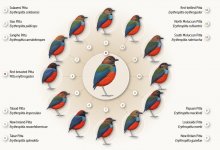Paul Clapham
Well-known member

For comparison, the latest Clements checklist has 17 species, arranged similarly. Differences:
- Philippine is split into Sulu (yairocho) and Blue-breasted (erythrogaster and propinqua)
- South Moluccan is split into Buru (rubrinucha) and Seram (piroensis)
- Papuan is split into Papuan (macklotii, loriae, digglesi), D'Entrecasteaux (finschii), and Habenicht's (habenichti)
H&M 4 has 1 species, divided into 8 subspecies groups. Differences:
- Group 1 lumps Philippine and Talaud
- Group 2 lumps Sangihe, Siao, Sulawesi, and Sula
- Papuan is split into group 6 (habenichti) and group 5 (kuehni, aruensis, macklotii, loriae, finschii)
- Group 7 lumps New Britain, New Ireland, and Tabar
- Philippine is split into Sulu (yairocho) and Blue-breasted (erythrogaster and propinqua)
- South Moluccan is split into Buru (rubrinucha) and Seram (piroensis)
- Papuan is split into Papuan (macklotii, loriae, digglesi), D'Entrecasteaux (finschii), and Habenicht's (habenichti)
H&M 4 has 1 species, divided into 8 subspecies groups. Differences:
- Group 1 lumps Philippine and Talaud
- Group 2 lumps Sangihe, Siao, Sulawesi, and Sula
- Papuan is split into group 6 (habenichti) and group 5 (kuehni, aruensis, macklotii, loriae, finschii)
- Group 7 lumps New Britain, New Ireland, and Tabar






